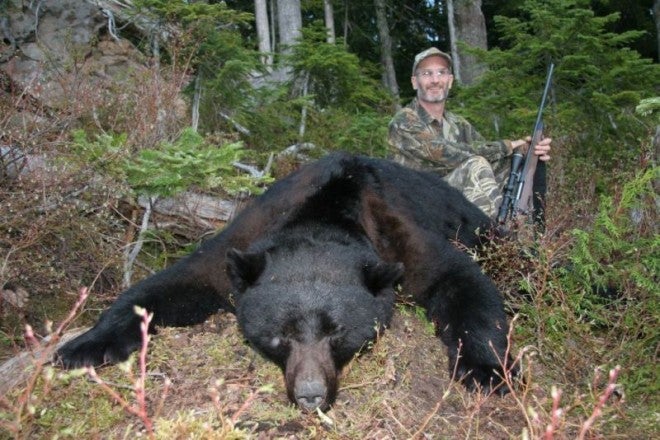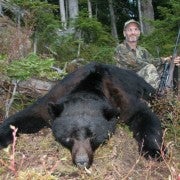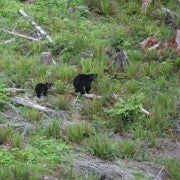CamoTherapy: the right bear
Andy Hahn 07.08.13

Last month marks the seventh anniversary of my Vancouver Island black bear hunt, and I have every reason to celebrate. I embarked on the adventure in early June 2006, shortly after learning I had ALS. Statistics show that most ALS patients die within five years of diagnosis. Not only am I still alive, I’m still hunting!
I had booked the hunt more than a year in advance—when I was in perfect health—with Darren DeLuca of Vancouver Island Guide Outfitters. As the date neared and my symptoms worsened, I kept Darren informed of my decreasing mobility. He assured me that we could still find bears in accessible locations.
My neurologist advised against going on any hunting trips because “it might be too strenuous.” I matter-of-factly told him it would be far worse for me if I didn’t go. My wife, Ligia, agreed that facing such challenges outweighs the pain of regretting missed opportunities for the rest of one’s life.
June finally arrived and we began the long journey from Rio de Janeiro to British Columbia. While hurrying to make a connection at the Dallas airport I was stopped by security agents because my reading glasses set off the metal detector. Most people would just feel their heart skip a beat in reaction to the surprise and sudden jolt of adrenaline; however, my neurological condition caused my legs to shake so badly that I had trouble standing. Although we sorted out the problem quickly, my legs kept trembling for another 20 minutes.
The remainder of the trip went well and Darren greeted us in Port Alberni around noon on Sunday, June 4. My guide, Kim Cyr, arrived soon after we reached the lodge. He eyed the walking staff I used to keep my balance, and explained the strategy we’d follow: Drive along logging roads, making frequent stops to glass clearings to locate bears. This style of hunting suited my physical condition
Ligia joined us for the afternoon hunt and marveled at the mountains’ rugged beauty. We saw blacktail deer and quite a few grouse, both ruffed and blue. The only bear we spotted was a young adult among whitened stumps in a logging slash. Definitely not a shooter but we had broken the ice!
The next day we saw eight bears, including juveniles, small adults and several sows with cubs. Numerous piles of bear scat littered the old logging roads, and Kim pointed out saplings that had been broken by boars to mark their territory. “Bears use these roads as game trails, so there’s a good chance we’ll bump into one if we put in the time,” he said. “It’ll be impossible for you to do any stalking in a slash because of the stumps and downed timber. We have to find the right bear in the right place.”
Tuesday’s hunt brought only two sightings by 6:30 p.m. Suddenly the moment of truth came as we rounded a bend on a rather open mountainside to see what resembled a black and furry VW Beetle on the road 100 yards ahead of us. Kim stopped the truck and I stepped out, pushing the clip into the .30-06. The big bear turned to face us, then sat on its haunches. Kim handed me the shooting sticks to support the rifle. “There’s your shot,” he said softly. “Center of the chest.”
Easier said than done! Similar to the airport incident, the adrenaline surge at sighting our long-sought quarry caused violent muscle spasms in my legs. I didn’t risk a shot because the dancing crosshairs would not hold steady. While I took a deep breath to regain my composure, the bear began walking slowly toward us. Twice it stopped and turned to offer me a perfect broadside opportunity, but my Human Earthquake act kept me from locking confidently on target.
Kim showed tremendous patience and understanding while waiting for my tremors to subside. And the bear kept plodding toward us. It finally stopped at a range of just 40 yards. After sniffing the air, the bruin turned and started ambling ever so slowly away from us. “This could be our last chance, Andy,” Kim said calmly. “Better take your shot.”
BAM!
I tried to place the bullet in the bear’s ribs but the angle proved too steep. Wounded in the right hip, it scrambled into the timber where I was unable to follow. I could only watch as Kim found the blood trail and disappeared in the woods. Several eternities passed before his .300 spoke once. A minute later he waved from the edge of the timber and shouted, “We got him! And he’s HUGE!”
I hadn’t dared to dream of harvesting such a trophy: The hide squared at 7 feet 2 inches and the skull scored 20 9/16 inches. Kim deserves all the credit for our successful hunt. He never backed down from the challenge of finding “the right bear in the right place” for a hunter with limited mobility.
This was my first experience as a disabled hunter, and it gave me the confidence to plan and enjoy many more adventures.

